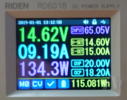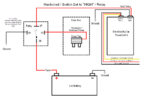Vortex Radar
Well-Known Member
- Joined
- Mar 26, 2014
- Messages
- 715
- Reaction score
- 1,101
- Location
- Seattle, Washington
- Country
- United States
k, all 3 batteries are in and I'm running parking mode tests.
I've got the U1000 on the iVolt Xtra, the A139 Pro on the Powercell 8, and the DR900X Plus on the B-130X.
View attachment 63084
Yep, I was thinking the same thing. Starting off I'm going with native(ish) options since I plan on doing individual reviews of each dashcam and I want to get as much testing done simultaneously as possible.I see that you have them hooked up by the manufacturer (Blackvue on Blackvue; and Thinkware on Thinkware)
Testing them on different dashcams can lead to variability in the results as different dashcams have different power usage requirements and it may not be enough for us to deduce which is the actual better backup battery solution (ex: parking mode results, which is more power efficient, which provides the most accurate estimated time remaining, which provides the most accurate estimated time to charge in a car)...
Or is your goal to test each of them on all the different dashcams? (test Blackvue battery on Thinkware, test Thinkware battery on Blackvue)...That seems like a lot of work.
Or maybe to save you time, the alternative here is to use "Power Cell 8" as a control of some sort by also testing it on both Thinkware and Blackvue dashcam since that one is platform agnostic and we will be able to infer from the result of your "Blackvue on Blackvue" vs "Thinkware on Thinkware" test.
Somewhat, yes. Things like native power cable options to simplify installation, plus the Thinkware battery has an extra output data cable that's designed to plug directly into future dashcams and add additional functionality. The Blackvue app also integrates dashcam functionality and battery monitoring into a single app which can be a plus too. So there will be some reasons to pick a native brand battery, besides just parking record times and battery recharge speeds.Are there any "special" integration benefits (besides not having to install an additional app) of using ex: "Blackvue battery on Blackvue dashcam" vs "Blackvue battery on Thinkware dashcam"?
Yep. I still need to doublecheck, but it looks like the Blackvue and Thinkware both support 24v vehicles. @BlackboxMyCar, does the Powercell 8 support 24v vehicles? Blackvue's battery officially supports it. Thinkwares does too, but it's not mentioned in the documentation.Any negatives/consequences (ex: an extra feature or benefit present in a battery that will not be available if you hooked it up to a non-branded dashcam) for doing mix & match besides having to install an additional app?
This sometimes happens with phones when you use a non-branded charger vs an official OEM charger as the charge rate maybe slower.
lol yeah, diving into all these nuances is the fun part.I hope your review plans to touch up on all these points.
Hey guys, diving in here. That's correct, the PowerCell 8 doesn't support 24V. We double-checked with EGENYep, I was thinking the same thing. Starting off I'm going with native(ish) options since I plan on doing individual reviews of each dashcam and I want to get as much testing done simultaneously as possible.
For a head-to-head comparison with all the dashcams, it makes more sense to pick one dashcam to use for all of them. Realistically I think they'll all produce comparable results, but it's still necessary to keep things as constant as possible.
Somewhat, yes. Things like native power cable options to simplify installation, plus the Thinkware battery has an extra output data cable that's designed to plug directly into future dashcams and add additional functionality. The Blackvue app also integrates dashcam functionality and battery monitoring into a single app which can be a plus too. So there will be some reasons to pick a native brand battery, besides just parking record times and battery recharge speeds.
Yep. I still need to doublecheck, but it looks like the Blackvue and Thinkware both support 24v vehicles. @BlackboxMyCar, does the Powercell 8 support 24v vehicles? Blackvue's battery officially supports it. Thinkwares does too, but it's not mentioned in the documentation.
Update: According to BBMC, the PC8 is 12v only.
Thinkware also has a more limited availability of input and output power cables. Blackvue has more and the BBMC option has the most. Ironically the Powercell 8 has an optional Thinkware output cable, for example, while the Thinkware battery only has an unspliced hardwire cable output.
lol yeah, diving into all these nuances is the fun part.
Thanks for confirming! Do you guys plan on carrying the BV and TW batteries?Hey guys, diving in here. That's correct, the PowerCell 8 doesn't support 24V. We double-checked with EGEN
Yo BBMC,Hey guys, diving in here. That's correct, the PowerCell 8 doesn't support 24V. We double-checked with EGEN
Haha noted, we'll pass this on to EGEN, yes sir!Yo BBMC,
The dash cam battery pack wars are heating up. lol
I'm testing the BlackVue B-130X, and so far it's making the PC8 look a little long in the tooth.
The BMS (battery management system) seems to be a little more advanced / sophisticated.
But it's nothing that can't be fixed with a good firmware update on the PC8.
The PC8 still has some tricks up it's sleeve like selectable charging rates from 4.5A to 9A when hardwired, (the B-130X is fixed at 9A).
Let's get the PC8 firmware updated, or hurry up with a Gen 2 model so it can compete at it's highest level.
-Chuck
Yep, we're already carrying the BlackVue B-130X (listed it for preorder yesterday on our website), but no plans for the TW battery at the moment.Thanks for confirming! Do you guys plan on carrying the BV and TW batteries?


You mean 12AWG right? lol(it would be better at 14 awg)
I just checked and I don't have any 12 awg wire. I'll have to order some. I also don't have any XT60 connectors. Where did you source your connectors from (Mouser)?You mean 12AWG right? lol
Do you have 10ft of 12AWG wire, and an XT60 connector to compare with the included 10ft 14AWG hardwire charge cable?
Based on my testing using a thicker gauge charge cable brings down the Amperage while charging, and of course the temperature of the wire.
I have spare XT60 connectors but I'm fresh out of 12AWG wire.



I bought the same brand name that both the PC8, and B-130X use. The brand name is called Amass. I bought a 10 pack of for $10. I used 3, I have 7 sitting here that I would gladly trade you for a 10ft piece of 12 AWG wire. LolI just checked and I don't have any 12 awg wire. I'll have to order some. I also don't have any XT60 connectors. Where did you source your connectors from (Mouser)?
I reviewed my previous Amazon orders and I found that I purchased 25ft of 12 awg full copper wire last August. I just located it in my garage after searching for about 10 minutes. This wire is all copper and not copper clad aluminum like the one your link pointed to on Amazon. https://www.amazon.com/gp/B0796L85CD I prefer to use solid copper rather than copper clad aluminum wire with higher amp loads.I bought the same brand name that both the PC8, and B-130X use. The brand name is called Amass. I bought a 10 pack of for $10. I used 3, I have 7 sitting here that I would gladly trade you for a 10ft piece of 12 AWG wire. Lol
However, given how thorough you are, you may want to also order the XT60 with “signal” pin so you can make a 12AWG charge cable to test the 5 AMP charge protocol.
Here is the XT60 connectors I bought;
https://www.amazon.com/gp/B074PN6N4K
Here is the 12AWG wire I would buy, (best value) $18 / 50ft;
https://www.amazon.com/gp/B00HZWYKF2
I looked, and looked for pure 100% oxygen free copper wire, and could not find it.This wire is all copper and not copper clad aluminum
